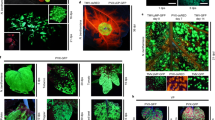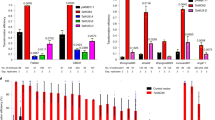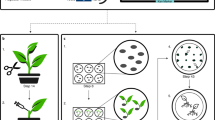Abstract
This protocol describes a method for high-frequency recovery of transgenic soybean, bean and cotton plants, by combining resistance to the herbicide imazapyr as a selectable marker, multiple shoot induction from embryonic axes of mature seeds and biolistics techniques. This protocol involves the following stages: plasmid design, preparation of soybean, common bean and cotton apical meristems for bombardment, microparticle-coated DNA bombardment of apical meristems and in vitro culture and selection of transgenic plants. The average frequencies (the total number of fertile transgenic plants divided by the total number of bombarded embryonic axes) of producing germline transgenic soybean and bean and cotton plants using this protocol are 9, 2.7 and 0.55%, respectively. This protocol is suitable for studies of gene function as well as the production of transgenic cultivars carrying different traits for breeding programs. This protocol can be completed in 7–10 months.
This is a preview of subscription content, access via your institution
Access options
Subscribe to this journal
Receive 12 print issues and online access
$259.00 per year
only $21.58 per issue
Buy this article
- Purchase on Springer Link
- Instant access to full article PDF
Prices may be subject to local taxes which are calculated during checkout





Similar content being viewed by others
References
McElroy, D. Valuing the product development cycle in agricultural biotechnology—what's in a name. Nat. Biotechnol. 22, 817–822 (2004).
Hinchee, M.A.W. et al. Production of transgenic soybean plants using Agrobacterium-mediated DNA transfer. Biotechnology 6, 915–922 (1988).
McCabe, D.E., Swain, W.F., Martinell, B.J. & Christou, P. Stable transformation of soybean (Glycine max) by particle acceleration. Biotechnology 6, 923–926 (1988).
Christou, P., Swain, W.F., Yang, N.S. & McCabe, D.E. Inheritance and expression of foreign genes in transgenic soybean plants. Proc. Natl. Acad. Sci. USA 86, 7500–7504 (1989).
Torisky, R.S. et al. Development of a binary vector system for plant transformation based on the supervirulent Agrobacterium tumefaciens strain Chry5. Plant Cell Rep. 17, 102–108 (1997).
Meurer, C.A., Dinkins, R.D. & Collins, G.B. Factors affecting soybean cotyledonary node transformation. Plant Cell Rep. 18, 180–186 (1998).
Maughan, P.J., Philip, R., Cho, M.J., Widholm, J.M. & Vodkin, L.O. Biolistic transformation, expression and inheritance of bovine b-casein in soybean (Glycine max). In Vitro Cell. Dev. Biol. 35, 334–349 (1999).
Santarem, E.R. & Finer, J.J. Transformation of soybean (Glycine max (L.) Merrill) using proliferative embryogenic tissue maintained on semi-solid Medium. In Vitro Cell. Dev. Biol. Plant 35, 451–455 (1999).
Zhang, Z.Y., Xiang, A.Q. & Staswick, Q. The use of glufosinate as a selective agent in Agrobacterium-mediated transformation of soybean. Plant Cell Tiss. Organ Cult. 56, 37–46 (1999).
Olhoft, P.M., Flagel, L.E., Donovan, C.M. & Somers, D.A. Efficient soybean transformation using hygromycin B selection in the cotyledonary-node method. Planta 216, 723–735 (2003).
Liu, H.K., Yang, C. & Wei, Z.M. Efficient Agrobacterium tumefaciens mediated transformation of soybeans using an embryonic tip regeneration system. Planta 219, 1042–1049 (2004).
Paz, M.M., Martinez, J.C., Kalvig, A.B., Fonger, T.M. & Wang, K. Improved cotyledonary node method using an alternative explant derived from mature seed for efficient Agrobacterium-mediated soybean transformation. Plant Cell Rep. 25, 206–213 (2005).
Behrens, M.R. et al. Dicamba resistance: enlarging and preserving biotechnology-based weed management strategies. Science 316, 1185–1188 (2007).
Dang, W. & Wei, Z. An optimized Agrobacterium-mediated transformation for soybean for expression of binary insect resistance genes. Plant Sci. 173, 381–389 (2007).
Aragão, F.J.L. et al. Inheritance of foreign genes in transgenic bean (Phaseolus vulgaris L.) co-transformed via particle bombardment. Theor. Appl. Genet. 93, 142–150 (1996).
Aragão, F.J.L. & Rech, E.L. Morphological factors influencing recovery of transgenic bean plants (Phaseolus vulgaris L.) of a Carioca cultivar. Int. J. Plant Sci. 158, 157–163 (1997).
Aragão, F.J.L., Vianna, G.R., Albino, M.M.C. & Rech, E.L. Transgenic dry bean tolerant to the herbicide glufosinate ammonium. Crop. Sci. 42, 1298–1302 (2002).
Vianna, G.R. et al. Fragment DNA as vector for genetic transformation of bean (Phaseolus vulgaris L.). Sci. Hortic. 99, 371–378 (2004).
Liu, Z., Park, B.J., Kanno, A. & Kameya, T. The novel use of a combination of sonication and vacuum infiltration in Agrobacterium-mediated transformation of kidney bean (Phaseolus vulgaris L.) with lea gene. Mol. Breed. 16, 189–197 (2005).
Umbeck, P., Johnson, G., Barton, K. & Swain, W. Genetically transformed cotton (Gossypium hirsutum L.) plants. Biotechnology 5, 263–266 (1987).
Keller, G. et al. Transgenic cotton resistant to herbicide bialaphos. Transgenic Res. 6, 385–392 (1997).
Bayley, C. et al. Engineering 2,4-D resistance into cotton. Theor. Appl. Genet. 83, 645–649 (1992).
Thomas, J.C. et al. Protease inhibitors of Manduca sexta expressed in transgenic cotton. Plant Cell Rep. 14, 758–762 (1995).
Agrawal, D.C. et al. In vitro induction of multiple shoots and plant regeneration in cotton (Gossypium hirsutum L.). Plant Cell Rep. 16, 647–652 (1997).
Sunilkumar, G. & Rathore, K.S. Transgenic cotton: factors influencing Agrobacterium-mediated transformation and regeneration. Mol. Breed. 8, 37–52 (2001).
Chaudhary, B. et al. Slow desiccation leads to high-frequency shoot recovery from transformed somatic embryos of cotton (Gossypium hirsutum L. cv. Coker 310 FR). Plant Cell Rep. 21, 955–960 (2003).
Leelavathi, S. et al. A simple and rapid Agrobacterium-mediated transformation protocol for cotton (Gossypium hirsutum L.): embryogenic calli as a source to generate large numbers of transgenic plants. Plant Cell Rep. 22, 465–470 (2004).
Sakhanokho, H.F. & Chee, P.W. The current status of gene transformation in cotton, SAAS Bull. Biochem. Biotech. 15, 34–46 (2002).
Rajasekaran, K., Hudspeth, R.L., Cary, J.W., Anderson, D.M. & Cleveland, T.E. High-frequency stable transformation of cotton (Gossypium hirsutum L.) by particle bombardment of embryogenic cell suspension cultures. Plant Cell Rep. 19, 539–545 (2000).
McCabe, D.E. & Martinell, B.J. Transformation of elite cotton cultivars via particle bombardment of meristems. Biotechnology 11, 596–598 (1993).
Aragão, F.J.L., Sarokin, L., Vianna, G.R. & Rech, E.L. Selection of transgenic meristematic cells utilizing a herbicidal molecule results in the recovery of fertile transgenic soybean (Glycine max (L.) Merril) plants at a high frequency. Theor. Appl. Genet. 101, 1–6 (2000).
Bonfim, K. et al. RNAi-mediated resistance to Bean golden mosaic virus in genetically engineered common bean (Phaseolus vulgaris). Mol. Plant Microbe Interact. 20, 717–726 (2007).
Aragão, F.J.L., Vianna, G.R., Carvalheira, S.B.R.C. & Rech,, E.L. Germ line genetic transformation in cotton (Gossypium hirsutum L.) by selection of transgenic meristematic cells with a herbicide molecule. Plant Sci. 168, 1227–1233 (2005).
Veltcheva, M., Svetleva, D., Petkova, S. & Perl, A. In vitro regeneration and genetic transformation of common bean (Phaseolus vulgaris L.)-problems and progress. Sci. Hortic. 107, 2–10 (2005).
Finer, J.J. & MacMullen, M.D. Transformation of cotton (Gossypium hirsutum L.) via particle bombardment. Plant Cell Rep. 8, 586–589 (1990).
Nunes, A.C. et al. RNAi-mediated silencing of the myo-inositol-1-phosphate synthase gene (GmMIPS1) in transgenic soybean inhibited seed development and reduced phytate content. Planta 224, 125–132 (2006).
Sanford, J. et al. An improved, helium-driven biolistic device. Technique 1, 3–16 (1991).
Shaner, D.L., Anderson, P.C. & Stidham, M.A. Imidazolinones: potent inhibitors of acetohydroxyacid synthase. Plant Physiol. 76, 534–546 (1984).
Sathasivan, K., Haughn, G.W. & Murai, N. Nucleotide sequence of a mutant acetolactate synthase gene from an imidazolinone resistant Arabidopsis thaliana var. Columbia. Nucleic Acids Res. 18, 2888 (1990).
Sambrook, J. & Russell, D.W. Commonly used techniques in molecular cloning. In Molecular Cloning: A Laboratory Manual 3rd edn. Vol. 3 (eds. Sambrook, J. & Russell, D.W.) Appendix 8-A8.20 (Cold Spring Harbor Laboratory Press, Cold Spring Harbor, New York, 2001).
Aragão, F.J.L., Grossi-de-Sá, M.F., Almeida, E.R., Gander, E.S. & Rech, E.L. Particle bombardment mediated expression of a Brazil nut methionine-rich albumin in bean (Phaseolus vulgaris L.). Plant Mol. Biol. 20, 357–359 (1992).
Trick, H.N. & Finer, J.J. Sonication-assisted Agrobacterium mediated transformation of soybean (Glycine max (L.) Merril) embryogenic suspension culture tissue. Plant Cell Rep. 17, 482–488 (1998).
Olhoft, P.M. & Somers, D.A. l-Cysteine increases Agrobacterium-mediated T-DNA delivery into soybean cotyledonary-node cells. Plant Cell Rep. 20, 706–711 (2001).
Hoekema, A., Hirsch, P.R., Hooykaas, P.J.J. & Schilperoort, R.A. A binary plant vector strategy based on separation of the vir and T-region of the Agrobacterium tumefaciens Ti plasmid. Nature 303, 179–180 (1983).
Birch, R.G. Plant transformation: problems and strategies for practical application. Annu. Rev. Plant Physiol. Plant Mol. Biol. 48, 297–326 (1997).
Altpeter, F. et al. Particle bombardment and the genetic enhancement of crops: myths and realities. Mol. Breed. 15, 305–327 (2005).
Acknowledgements
The authors are grateful to Ana C.M.M. Gomes for scanning electron microscopy assistance and to Ivete M. Bernardes for diagram design. This study was supported by BASF and Empresa Brasileira de Pesquisa Agropecuária—EMBRAPA.
Author information
Authors and Affiliations
Contributions
All the authors made the same contribution to this work.
Corresponding authors
Rights and permissions
About this article
Cite this article
Rech, E., Vianna, G. & Aragão, F. High-efficiency transformation by biolistics of soybean, common bean and cotton transgenic plants. Nat Protoc 3, 410–418 (2008). https://doi.org/10.1038/nprot.2008.9
Published:
Issue Date:
DOI: https://doi.org/10.1038/nprot.2008.9
This article is cited by
-
Target lines for recombinase-mediated gene stacking in soybean
Theoretical and Applied Genetics (2022)
-
Functional characterization of the pUceS8.3 promoter and its potential use for ectopic gene overexpression
Planta (2022)
-
Genetic transformation of legumes: an update
Plant Cell Reports (2021)
-
Improved cotton transformation protocol mediated by Agrobacterium and biolistic combined-methods
Planta (2021)
-
Pyramiding dsRNAs increases phytonematode tolerance in cotton plants
Planta (2021)
Comments
By submitting a comment you agree to abide by our Terms and Community Guidelines. If you find something abusive or that does not comply with our terms or guidelines please flag it as inappropriate.



